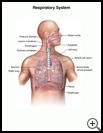
Pneumonia
What is pneumonia?
Pneumonia is infection of one or both of your lungs. The infection causes swelling (inflammation) of the air sacs in your lungs. The air sacs may fill with fluid or pus and cause you to cough or have trouble breathing. Pneumonia may be caused by a virus, bacteria, or fungus and may be mild or severe. You may be more at risk for a pneumonia infection if:
- You were sick with another illness and your immune system was unable to fight a second illness in your lungs
- You had an injury that damaged your lungs, such as a chest injury or breathing in smoke from a fire
- You have a chronic illness, such as diabetes, chronic bronchitis, or cancer. These and other illnesses can put you at risk for getting infections
- Your stomach contents (food and liquids) backed up into your esophagus and trachea and you breathed it into your lungs
- You have recently had surgery with general anesthesia
- You are over age 65. Children under age 2 are also at higher risk.
What can I expect in the hospital?
You need to stay in the hospital because you have one or more of the following:
- A lot of trouble breathing
- A very low oxygen level
- It's hard for you to drink enough fluids
- You have other medical conditions that are worsened because you have pneumonia
Several things may be done while you are in the hospital to monitor, test, and treat your condition. They include:
Monitoring:
- You will be checked often by the hospital staff.
- Your blood oxygen level will be monitored by a sensor that is attached to your finger or earlobe.
- Your heart rate, blood pressure, and temperature will be checked regularly.
- Your fluid intake may be monitored closely by keeping track of everything you eat and drink and any IV fluids you receive.
Testing:
Testing may include:
- Arterial blood gas (ABG): A blood test to measure the levels of oxygen and carbon dioxide in your blood. It also measures the balance of chemicals (acids and bases) in your blood, called the pH
- Blood tests to check for infections
- X-rays, which use energy called radiation to make pictures of the inside of your bones, tissues, and organs. You may have chest X-rays, which are pictures of your lungs inside of your chest to check for pneumonia. X-rays may be taken several times while you are in the hospital to see if your pneumonia is improving with treatment, and for other problems
- Sputum culture, which is a test in which fluid made in the lungs is tested for a cause of your infection, such as bacteria or a virus
Treatment:
The treatment for pneumonia depends on its cause, your symptoms, how well you respond to treatment, your overall health, and any complications you may have.
- You will have a small tube (IV catheter) inserted into a vein in your hand or arm. This will allow medicine to be given directly into your blood and to give you fluids, if needed.
- You may receive oxygen through a small tube placed under your nose or through a mask placed over your face.
- Your provider may prescribe medicines to:
- Treat the infection
- Reduce fever
- Relax and open the airways
- Reduce swelling in your lungs
- Loosen the mucus in your lungs and help you cough it up
- Your provider may recommend other types of therapy to help relieve pain, other symptoms, or side effects of treatment.
What can I do to help?
- You will need to tell your healthcare team if you have new or worsening:
- Shortness of breath
- Chest pain when you take a breath
- Wheezing
- Coughing up mucus that is thick or blood-stained
- Ask questions about any medicine, treatment, or information that you do not understand.
How long will I be in the hospital?
How long you stay in the hospital depends on many factors. The average amount of time to stay in the hospital to treat pneumonia is 4 to 6 days. Your provider will make sure that you are breathing easily, your oxygen levels and other medical conditions are stable, and that you will be able to care for yourself when you go home.
Last modified: 2016-02-18
Last reviewed: 2016-02-12

